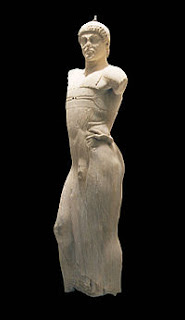After a bit of delay getting started, our bus embarked on an hour and a half journey to the town of Casale where an unusually opulent Roman villa, dating from the early 5th century C.E., was largely preserved due to a mud slide that buried it for a thousand years.
The villa is huge, even by the standards of Roman nobles, which has given rise to speculation that it may have belonged to an emperor. There is no evidence to support this, but the spectacular size and opulence indicate that the owner must have been someone of great importance in the late Roman Empire.
Our local guide overwhelmed us with too much information, beginning with a look at the Roman baths that were attached to the house. Most Romans would have attended a public bath house. The fact that this villa had a fully functioning bath of its own is quite extraordinary.
The baths, like all of the rooms in the villa, was decorated by floors of marble mosaics that indicated the function of the room.
After viewing the baths, we reached the portico where guests would have arrived at the villa. A triple gate and an array of fountains would have overwhelmed the arriving guest. The beautiful mosaic floors of the entrance hall would give a taste of what the entirety of the villa would have in store.
From the entrance hall, the guest would have entered the central courtyard of the villa. It was an open garden with fountains, surrounded by porticos with mosaic floors featuring wild animals and a roof held up by columns.
One side of the courtyard featured the residence of the villa's owner and his family. These rooms are large and decorated with mosaics representing Homeric tales, gods and goddesses, and children acting out parodies of classical stories.
The opposite side had an array of guest rooms, as well as kitchens and dining rooms where guests could be entertained. Adjacent rooms with mere geometric pattern mosaics were those used by servants tending to the needs of the guests.
Along the fourth side of the courtyard is a very long hallway, separating the living quarters from the business side of the villa. The hallway is decorated with scenes of the capture of wild animals of all sorts representing animals brought from all corners of the Roman Empire, as even as far to the east as India.
The main room on the business side of the villa is a large basilica that could easily accommodate dozens and dozens of people who might come before the villa owner to conduct affairs. Despite the prattle of our guide, the villa was quite an amazing sight to see.
After finishing our visit to the villa, we drove another hour through agricultural territory to a winery that is owned by two sisters. This women owned and operated farm also served us a very nice lunch at tables set amid the stainless steel tanks in which wine was fermenting around us.
Heavy rain came down as we were eating, so we could not go into the vineyards, but one of the sisters provided detailed explanation of the wines produced here.
Another hour and a half on the bus brought us to the city of Ragusa, where we will be staying the next three days. From a distance, the city looks to have been built vertically on the steep hillside. Once in the town, it becomes clear that there are actual streets, though many are steep and narrow.
Our hotel is a rather old building near the center of the historic city, but very adequate. We enjoyed a light supper at a restaurant a few blocks away, and will have a full tour tomorrow.


























































